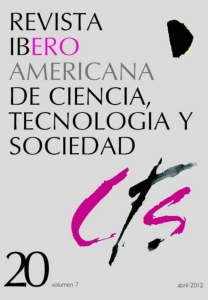Technology advice in real time
birth and first steps of the NANOMAC project
DOI:
https://doi.org/10.52712/issn.1850-0013-692Keywords:
technology, advice, reflexivity, nanotechnologyAbstract
This paper addresses the benefits of being involved from the start in advising on technology by analyzing the theoretical background of Constructive Technology Assessment. It also describes the cooperative and collaborative activity developed in the design and knowledge transfer throughout the development of the NANOMAC project. Reflective experience has made possible the evolution both of the project and of the methodology of Real-Time Advice in order to implement the ELSI values in the artefacts generated by research projects.
Downloads
References
BOXEL, J. van (1994): “Constructive Technology Assessment: A New Approach for Technology Assessment Developed in the Netherlands and its Significance for Technology Policy”, en G. Aicholzer y G. Schienstock (eds.): Technology Policy: Towards an Integration of Social and Ecological Concerns, Berlín/Nueva York, De Gruyter.
GONZALEZ GARCÍA, M. I.; LOPÉZ CEREZO, J. A. y LUJÁN, J. L. (eds.) (1996): Ciencia, tecnología y sociedad. Una introducción al estudio social de la ciencia y la tecnología, Madrid, Tecnos.
GUSTON, D. (2006): “Real-time Technology Assessment”. Disponible en: http://nanohub.org/resources/1224.
GUSTON, D. y SAREWITZ, D. (2002): “Real-Time Technology Assessment”, Technology in Society,vol. 24, pp. 93-109.
JASANOFF, S. (1996): “Beyond Epistemology: Relativism and Engagement in the Politics of Science”, Social Studies of Science,vol. 26, nº 2, pp. 393-418.
JASANOFF, S. (ed.) (2004): States of Knowledge: The Co-Production of Science and Social Order, Londres, Routledge.
JASANOFF, S. (2005): Designs on Nature: Science and Democracy in Europe and the United States,Princeton, N.J., Princeton University Press.
KELTY, C. (2008): “Allotropes of Fieldwork in Nanotechnology”, en F. Jotterand (ed.): Emerging Conceptual, Ethical and Policy Issues in Bionanotechnology, Philosophy and Medicine, vol. 101, part 4, Springer Science + Business Media B.V., pp. 157-180.
RIP, A. (1986): “Controversies as informal technology assessment”, Knowledge, Creation, Diffusion, Utilization,vol. 8, nº 2, pp. 349-371.
RIP, A. (2008): “Nanoscience and Nanotechnologies: Bridging Gaps Through Constructive Technology Assessment”, en G. Hirsch Hadorn et al (eds.): Handbook of Transdisciplinary Research,Springer, pp. 145-157.
RIP, A. y VAN DEN BELT, H. (1988): Constructive Technology Assessment: Toward a Theory,Enschede,Universidad of Twente.
RIP, A. y MISA, T.J. et al (eds.) (1995): Managing Technology in Society. The Approach of Constructive Technology Assessment,Londres, Pinter Publishers.
SCHOT, J. W. (1992): “Constructive Technology Assessment and Technology Dynamics: The Case of Clean Technologies”, Science Technology and Human Values, vol. 17, pp. 36-56.
SCHOT, J. y RIP, A. (1997): “The Past and Future of Constructive Technology Assessment”, Technological Forecasting and Social Change,vol. 54, pp. 251-268.
SLAA, P. y TUININGA, E. J. (1989): “Constructing Technology with Technology Assessment”, en M.A. Quintanilla (ed.): Evaluación parlamentaria de las opciones científicas y tecnológicas, Madrid, Centro de Estudios Constitucionales.
SMITS, R. E. H. M. (1990): State of the Art of Technology Assessment in Europe,The Commission of the European Communities.
Downloads
Published
How to Cite
Issue
Section
License
Copyright (c) 2024 CC Attribution 4.0

This work is licensed under a Creative Commons Attribution 4.0 International License.
All CTS's issues and academic articles are under a CC-BY license.
Since 2007, CTS has provided open and free access to all its contents, including the complete archive of its quarterly edition and the different products presented in its electronic platform. This decision is based on the belief that offering free access to published materials helps to build a greater and better exchange of knowledge.
In turn, for the quarterly edition, CTS allows institutional and thematic repositories, as well as personal web pages, to self-archive articles in their post-print or editorial version, immediately after the publication of the final version of each issue and under the condition that a link to the original source will be incorporated into the self-archive.











